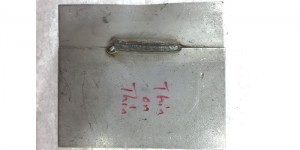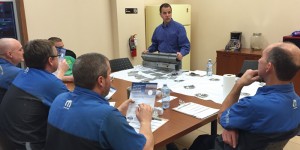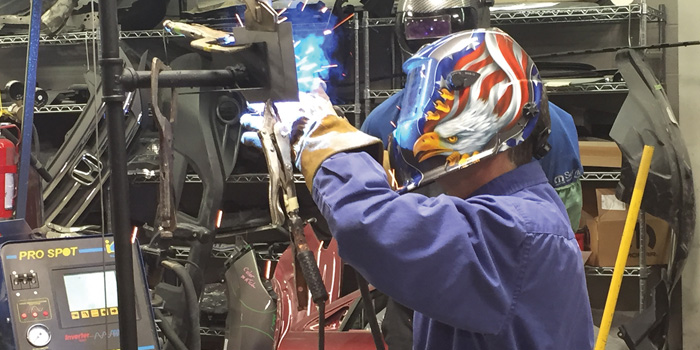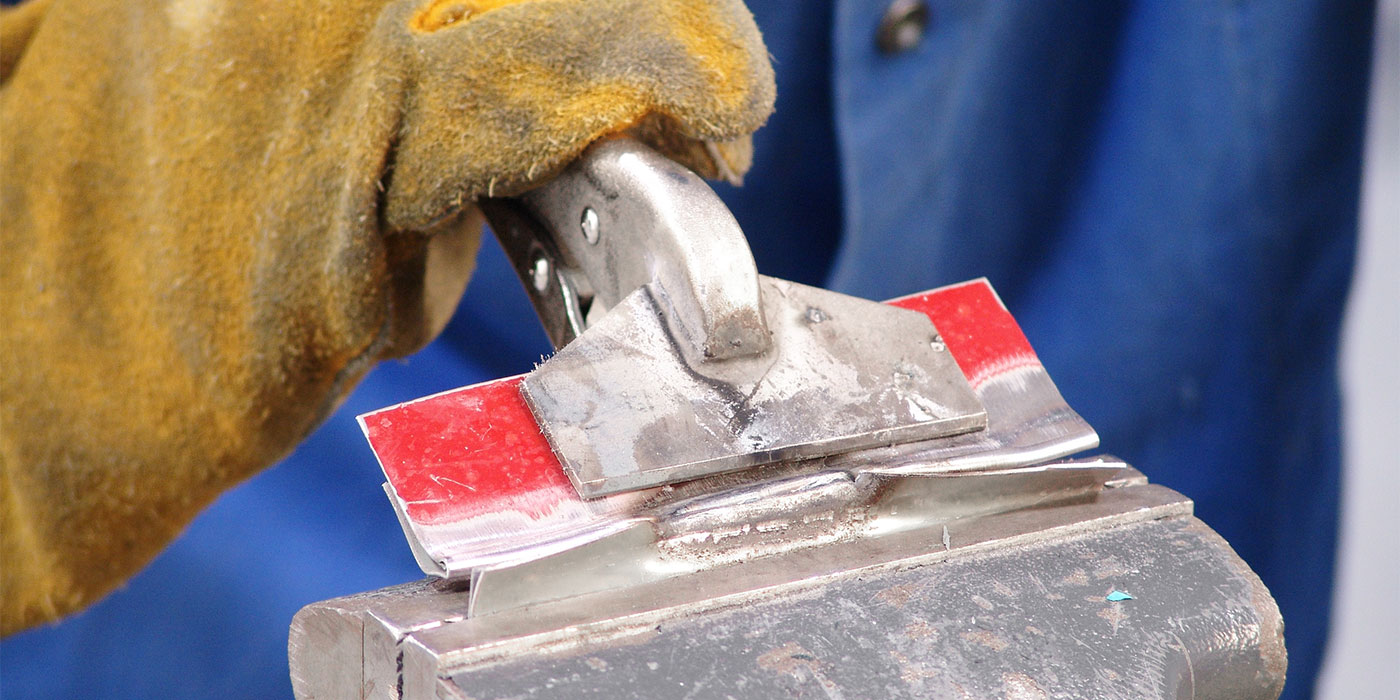As I’ve said many times before, “Collision technicians are an interesting mix of both scientist and artist.”
Many people lose sight of the fact that a vehicle needs to go back together to exact OEM specifications (scientist) and look like it did when it came off the showroom floor (artist). If either aspect of the repair is “off,” then the vehicle wasn’t properly repaired. It’s a fine balance between these two aspects, and a true collision professional achieves this with a vehicle that’s in pieces when it arrives in their repair stall.
When welding on a customer’s vehicle, both the art and the science are immediately evident in the repair. There’s no way to hide a bad weld, and there’s no way to show off a good weld. Your welds exist under hoods, obscured by moldings, under carpets and tucked behind other panels, and are ready for anyone who takes the time to look at them. As a technician, you don’t want someone to find a bad weld that you performed and – even worse – a weld that failed and ended with catastrophic results.
For this month’s article, we’re going to look at MIG (Metal Inert Gas) welding technology and considerations for aluminum, steel and silicon bronze applications. As an industry, we’ve been MIG welding for quite awhile now. However, the materials we’re welding have been changing and we’re seeing more aluminum vehicles and panels in the shop now than ever before.
MIG welders come in two basic types of technology for delivering power to the welding tip: transformer and inverter.
Transformer MIG welders have been around for a long time. These large and heavy welders are still used and can be purchased brand new by shops today. They’re less expensive than inverter welders, simple to use, are very durable and work well on older types of steels. However, transformer welders have their drawbacks as well, including adjustments that are stepped and not linear and that they may not meet OEM weld requirements.
Inverter MIG welders are “newer” to the welding arena, but have still been around for more than 20 years. They’re typically smaller and lighter, consume less power, are more energy efficient, provide finer controls over weld settings, provide more flexibility with a wider range of welds that can be performed, are able to meet OEM welding guidelines and are able to weld newer substrates. Drawbacks are that they’re generally more expensive than transformer welders and require a technician to attend training courses to fully understand how to leverage the welding machine’s capabilities to create consistently strong welds that meet OEM requirements.
Shielding Gas
In collision repair shops, MIG welding calls for a combination of argon and carbon dioxide in a 75/25 mix for steels. However, aluminum and silicon bronze welding require 100 percent argon shielding gas. Be careful to use the proper shielding gas for the materials being welded.
Transfer Methods
Depending on the substrate and the welding requirements, you could be using spray transfer (typically with aluminum), short circuit transfer (typically used with steels and silicon bronze), pulsed spray transfer or globular transfer methods.

Electrode Wire
Included in this mix are the substrate and welding wire being used. Let me get this out in the open right away: one type of welding wire does not work for all substrates. Different OEMs may call out a different welding wire for their vehicles. From 2004 to 2014, Ford required ER70S-3 or equivalent wire to be used when welding the front frame rails on an F-150. That same procedure specifies the use of a 220V welder capable of producing 200 amps, instead of a 110V welder, to properly complete the repair. Surprisingly, the 2015 Ford F-150 frame sectioning procedures do not specify the welder or wire type or size. If you don’t believe me, go take a look at your ALLDATA subscription and see for yourself.
Choosing a MIG Welder
As with any piece of equipment you’re going to purchase for your shop, buying a quality MIG welder takes a little research and some soul searching to determine what the best fit for your shop is going to be for now and in the near future. I say this only because I’ve visited shops that said, “We just don’t want to get into aluminum.” Not that long ago, I heard shop owners saying the same thing about high-strength steels on those European cars. “We don’t work on ‘those’ cars in my shop.” You probably still don’t work on “those” cars, but the high-strength steel technology is now commonplace in the collision industry.
Whether you want to get into aluminum or not, you should be planning for it because it’s already coming into your shop. Doors, hoods, trunk lids, fenders and all-aluminum vehicles are already there. OEMs are looking for any way possible to shed weight, meet current safety ratings and increase the fuel economy of their current fleet. CAFE (Corporate Average Fuel Economy) standards are forcing OEMs to look for every single pound to eliminate from their vehicles. Aluminum usage in vehicles is only going to increase in the coming years, and “those” vehicles will be greeting you soon enough. I say all of this because it’s important to understand the latest industry trends when selecting new equipment. There’s a steep learning curve when learning how to work with aluminum, but wasn’t there a steep learning curve when unibody cars first hit the market in the 70s?
In fact, you should consider a MIG welder that’s ready for steel, silicon bronze and aluminum. Several manufacturers have three-torch MIG welders that allow the technician to seamlessly move from steel to silicon bronze welding to aluminum, including supplying the correct shielding gas, all within the same welder. This is especially handy when you’re putting on a quarter panel on a Toyota Camry. Toyota calls for both steel and silicon bronze welding during this repair. Who wants to set up the welder twice in order to do this repair? Neither you nor your technicians, that’s for sure.
MIG steel welding is not a substitute for silicon bronze welding. Silicon bronze has a much narrower heat transfer zone than steel welding and takes less grind time after the weld has been completed. OEMs call for silicon bronze in a number of procedures, especially when heat is going to be an issue where the panels are attached and any of the surrounding panels. Using steel MIG welding instead of silicon bronze in those areas is a recipe for repairing a vehicle to a total loss.
When you’re looking at MIG welders for your facility, make sure to consider synergic pulse welders. Synergic implies full electronic control of the welder using two knobs or less. The welder typically stores and recalls weld programs for the different substrates with user adjustments available in order to help the operator adjust the machine to achieve optimal results. In other words, these welders are ideal for those individuals with limited welding training or who do not weld on a daily basis.
Common Mistakes
When it comes right down to it, there are a handful of mistakes that are typically made when using a MIG welder. Honestly, the most common mistake is assuming the welder is ready and all set up for the materials you’ll be welding. Based on OEM requirements for welding, we may have to make several adjustments to the machine before we start.
Going hand-in-hand with the most common mistake, the second most common mistake is not reviewing the OEM welding requirements for the specific vehicle and parts being welded. How do you know what you’re going to be doing if you don’t review the repair information? You don’t.
The third most common mistake is not conducting test welds and destructive tests before beginning repairs to the vehicle. This is not a step you can bypass in the interest of saving time. As a collision repair professional, you have to ensure that your welds are going to meet the OEM repair requirements and are strong enough to put that family back in their repaired vehicle.
The fourth most common mistake involves the actual setup of the welder. Make sure you have the correct liner, contact tip diameter, drive rollers, wire size, nozzle type (steel or aluminum), welder program and shielding gas.
The fifth most common mistake is the lack of training for your technician, training being formal welding training and product-specific training on the welding equipment being used. If you have multiple MIG welders in your shop, it’s easy for someone to say they know how to use a MIG welder. The question you need to ask is, “Do they know how to use this specific MIG welder?”
Don’t fall into the trap of thinking that because your A tech has been working for you forever, he knows everything. He doesn’t. Provide training to everyone using any new piece of equipment and validate that they can use it properly before they start billing their time using it. If nothing else, it’s for their safety and the safety of your customers.
The sixth and final most common mistake is failing to perform maintenance on your MIG welder. Check to see if the gas is leaking, you have a supply of contact tips available, the plug and electrical cord are not damaged, the torch head is not broken or damaged and the electrode wire is not corroded. Wear and tear happens, so make sure that you’re evaluating a MIG welder’s condition on a monthly basis. Maintenance cycles may be more or less depending on how much you use your welder.

Quality Repairs Count
Every time I see a quality structural repair, it makes me smile. I think about the amount of dedication that it takes, not only from the technician but the entire shop staff.
While we only spoke about one piece of equipment in this article, there are many tools, various materials, all kinds of parts and a bunch of individuals involved in producing a quality and safe product for your customers. I’m proud of this industry and the effort each of you puts forth every day to keep families safe on the roads. I tip my hat to each one of you and your families during this holiday season.
Be safe, and happy repairing!
Contributors to this article include Bill Berman – president, Cebotech; Bruno Bouygues – group CEO, GYS; Art Ewing – sales and marketing director, Pro Spot; Tom McGee – business development manager, Spanesi-Americas; and Audie Swedeen – EVP/COO, AccuracyDriven4.















